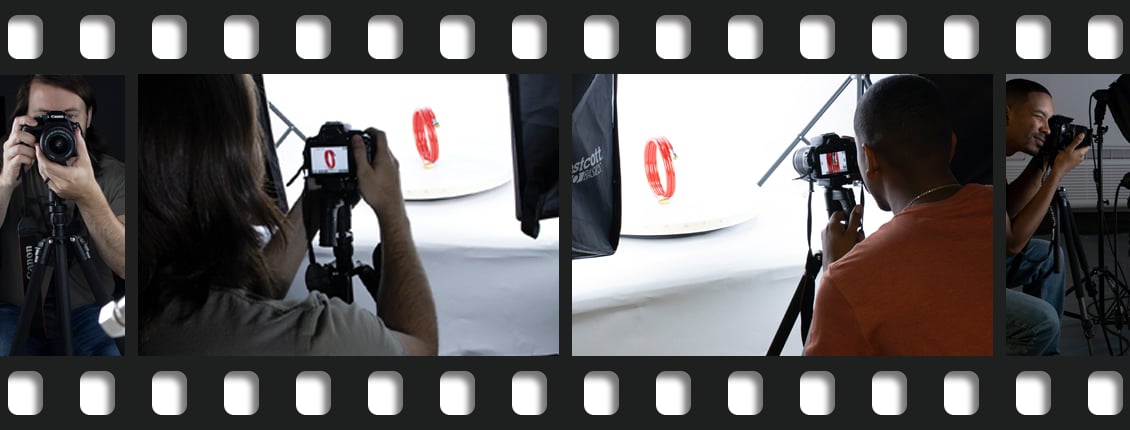
And does it matter?
In this age of online shopping, excellent, informative photos of your product are a must. They are the virtual replacement of the retail hands-on experience. That’s why you need to not only understand what is product photography, but why you need to make it a top priority.
Why product photos are important
Just like the words describing your product act as your virtual salesperson (learn more here), photos are the virtual equivalent of a sample product on a retail sales floor. Although a website shopper can’t touch or feel the product, through product photography, they can see it from multiple angles and get a clear understanding of its details or finer points.
We humans are made to respond to images. Unlike text that requires a linear process of reading, photos immediately processed as a whole. Shutterstock.com reveals that:
“90 percent of information transmitted to the brain is visual. Images that contain physical subjects and a variety of colors increase willingness to read by 80 percent. They also mean less work for our brains, which can process visuals 60,000 times faster than text and identify images seen for as few as 13 milliseconds…Furthermore, because our brains are trained to decipher all the elements of an image at the same time, we are able to make an association with an image, both cognitively and emotionally, in a quicker manner. This means that images are a great way to grab a viewer’s attention, convey a message, and elicit an emotional response.”
Basically, when online shoppers are on the hunt for a product, they quickly scroll through the possibilities. What causes them to stop and investigate further is the photo. It’s that simple.
Or is it?
Because any old photo won’t do.
What kinds of product photos are there?
There’s a temptation when it comes to online selling to think a casual snapshot will work. Trust us; it won’t. Everyone is bringing their A game to online product photography. Quality and composition rival or exceed what’s been the gold standard for print. Plus, there’s the added complication of the differing requirements across multiple online platforms.
There are a variety of photos every manufacturer should be prepared to provide. The two basic kinds are:
- Product photos over a seamless white background, taken from multiple angles, as well as detail shots of important selling-point features, also over white
- Photographs showing use in context, also known as lifestyle photos; modified lifestyle photos introduce a hand or part of the human body into the photo, providing some in-use context
Additional kinds of photos that may be required or desirable include:
- 360° photos—a series of stills shot on a turntable that, when married with special software, create a smooth view all the way around a product
- Ghost mannequin over white—a wearable product that is fully dimensional but you can’t see the model, plus you see the area of the clothing typically blocked by the neck or some other part of the body
- Super high-resolution photos for zooming/magnification
Not every selling platform requires all of these. Many only require photos with the white background. But if you want your photos to sell your products, take the additional time and expense to at least do lifestyle product photography. And if what you produce is clothing, ghost mannequin shots are indispensable.
What makes a good product photo?
Photography is an art form. Those who practice it are passionate about their tools. Some insist a late model smartphone will do the job while others insist on DSLR cameras. Most feel a tripod is a must. All agree, however, that good lighting, exposure, and focus are crucial.
The goal is to generate photos that grab attention while accurately portraying your product. Ideally, they should require minimal post-shoot touchup work. This means you need photos that:
- Are properly exposed so colors, shapes, and details can be seen
- Are correctly focused from the get-go—there’s only so much that can be done in Photoshop
- Have lighting that looks natural and doesn’t cast harsh shadows
- Show the product as the full-screen hero, not as the off-to-one-side sidekick
- Show the product in the proper context when it comes to lifestyles
- Don’t use odd effects or backgrounds simply because it looks cool—if it distracts from the product, skip them
So, what is product photography? Ultimately, product shots that capture sales!
What photo requirements do ecommerce sites have?
That’s a great question. The answer is a moving target. Here are links to the current photo requirements of seven popular online selling platforms. Each platform has other helpful selling tools you can browse for. A general average for the number of photos required is three—all over a seamless white background. But that can vary between platforms.
Sounds to me that “What is Product Photography” is more than meets the eye!
Yes! It takes patience, planning, skill, knowing what sells, and knowing what the shopping platforms want. Photos that sell don’t magically happen.
If you do decide you want to do your own, set up a dedicated team and give them the tools they need. But if you decide to outsource your product photography, choose a company with skilled photographers that are also familiar with ecommerce needs—like the media team at Petra Industries!
A picture is worth 1,000 words
Here at Petra, we work with many manufacturers and ecommerce sites. And we’ve pretty much seen it all. It’s why we have a dedicated media team that works with each manufacturer to ensure the photos we receive meet all of the various online standards. We can also handle your photography needs.
If you find yourself wondering what you need to provide us, or would like to know more about our Product Photography Services department, be sure to visit our website then check with your vendor brand manager.
Now more than ever, photos capture sales before a word is even read.
